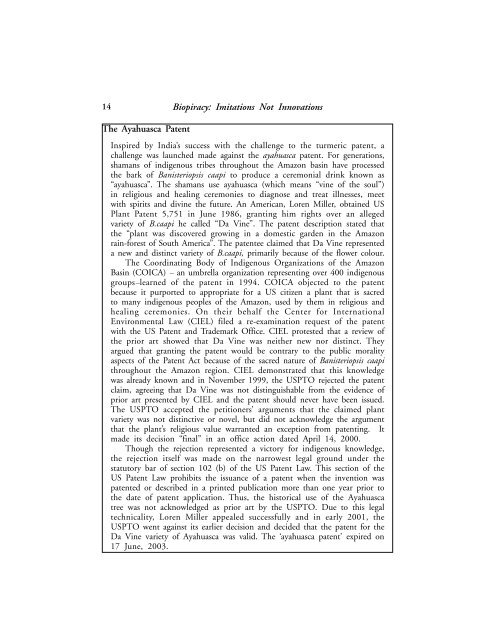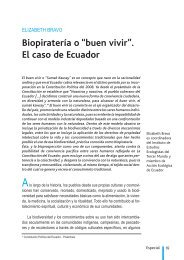BIOPIRACY Imitations Not Innovations - Biopirateria
BIOPIRACY Imitations Not Innovations - Biopirateria
BIOPIRACY Imitations Not Innovations - Biopirateria
Create successful ePaper yourself
Turn your PDF publications into a flip-book with our unique Google optimized e-Paper software.
14 Biopiracy: <strong>Imitations</strong> <strong>Not</strong> <strong>Innovations</strong><br />
The Ayahuasca Patent<br />
Inspired by India’s success with the challenge to the turmeric patent, a<br />
challenge was launched made against the ayahuasca patent. For generations,<br />
shamans of indigenous tribes throughout the Amazon basin have processed<br />
the bark of Banisteriopsis caapi to produce a ceremonial drink known as<br />
“ayahuasca”. The shamans use ayahuasca (which means “vine of the soul”)<br />
in religious and healing ceremonies to diagnose and treat illnesses, meet<br />
with spirits and divine the future. An American, Loren Miller, obtained US<br />
Plant Patent 5,751 in June 1986, granting him rights over an alleged<br />
variety of B.caapi he called “Da Vine”. The patent description stated that<br />
the “plant was discovered growing in a domestic garden in the Amazon<br />
rain-forest of South America”. The patentee claimed that Da Vine represented<br />
a new and distinct variety of B.caapi, primarily because of the flower colour.<br />
The Coordinating Body of Indigenous Organizations of the Amazon<br />
Basin (COICA) & an umbrella organization representing over 400 indigenous<br />
groups&learned of the patent in 1994. COICA objected to the patent<br />
because it purported to appropriate for a US citizen a plant that is sacred<br />
to many indigenous peoples of the Amazon, used by them in religious and<br />
healing ceremonies. On their behalf the Center for International<br />
Environmental Law (CIEL) filed a re-examination request of the patent<br />
with the US Patent and Trademark Office. CIEL protested that a review of<br />
the prior art showed that Da Vine was neither new nor distinct. They<br />
argued that granting the patent would be contrary to the public morality<br />
aspects of the Patent Act because of the sacred nature of Banisteriopsis caapi<br />
throughout the Amazon region. CIEL demonstrated that this knowledge<br />
was already known and in November 1999, the USPTO rejected the patent<br />
claim, agreeing that Da Vine was not distinguishable from the evidence of<br />
prior art presented by CIEL and the patent should never have been issued.<br />
The USPTO accepted the petitioners’ arguments that the claimed plant<br />
variety was not distinctive or novel, but did not acknowledge the argument<br />
that the plant’s religious value warranted an exception from patenting. It<br />
made its decision “final” in an office action dated April 14, 2000.<br />
Though the rejection represented a victory for indigenous knowledge,<br />
the rejection itself was made on the narrowest legal ground under the<br />
statutory bar of section 102 (b) of the US Patent Law. This section of the<br />
US Patent Law prohibits the issuance of a patent when the invention was<br />
patented or described in a printed publication more than one year prior to<br />
the date of patent application. Thus, the historical use of the Ayahuasca<br />
tree was not acknowledged as prior art by the USPTO. Due to this legal<br />
technicality, Loren Miller appealed successfully and in early 2001, the<br />
USPTO went against its earlier decision and decided that the patent for the<br />
Da Vine variety of Ayahuasca was valid. The ‘ayahuasca patent’ expired on<br />
17 June, 2003.



